How to Build Company Culture: Effective Strategies for a Cohesive Team

Imagine a workplace where employees feel valued, motivated, and aligned with the company’s mission. This is the power of a strong company culture.
Understanding how to build company culture is essential for any thriving organization, as it shapes the behavior and decision-making processes of your team. It's about creating an environment where trust and communication flourish, aligning everyone towards shared goals, and fostering a sense of belonging.
In this article, we will explore effective strategies to build and maintain a cohesive and positive company culture.
From defining core values and assessing the current cultural climate to recognizing employees and encouraging open communication, these strategies will help you create a workplace where employees thrive, and the organization excels.
Key Takeaways
- A robust company culture aligns with core values and enhances trust.
- Continuous assessment and employee involvement are vital for cultural growth.
- Culture is dynamic, necessitating ongoing refinement and management.
What is company culture?
Company culture is the collective set of values, beliefs, and behaviors that define how an organization operates and how its members interact. It’s the unseen force that influences everything from decision-making processes to employee engagement and customer satisfaction.
At its core, company culture is shaped by the company's mission statement, vision, and values, but it is also reflected in everyday practices, leadership styles, and the workplace environment.
Understanding company culture is crucial for long-term success because it directly impacts employee engagement, productivity, and overall job satisfaction.
A positive company culture fosters a sense of belonging and purpose, which can lead to higher motivation, better performance, and increased retention rates. Conversely, a negative culture can result in high turnover rates, low morale, and decreased productivity.
Our research has shown that organizations with strong, positive cultures see significant improvements in employee engagement, which in turn drives business success. We found that employees who strongly agree that they feel connected to their organization’s culture are 5.2x as likely to be engaged.
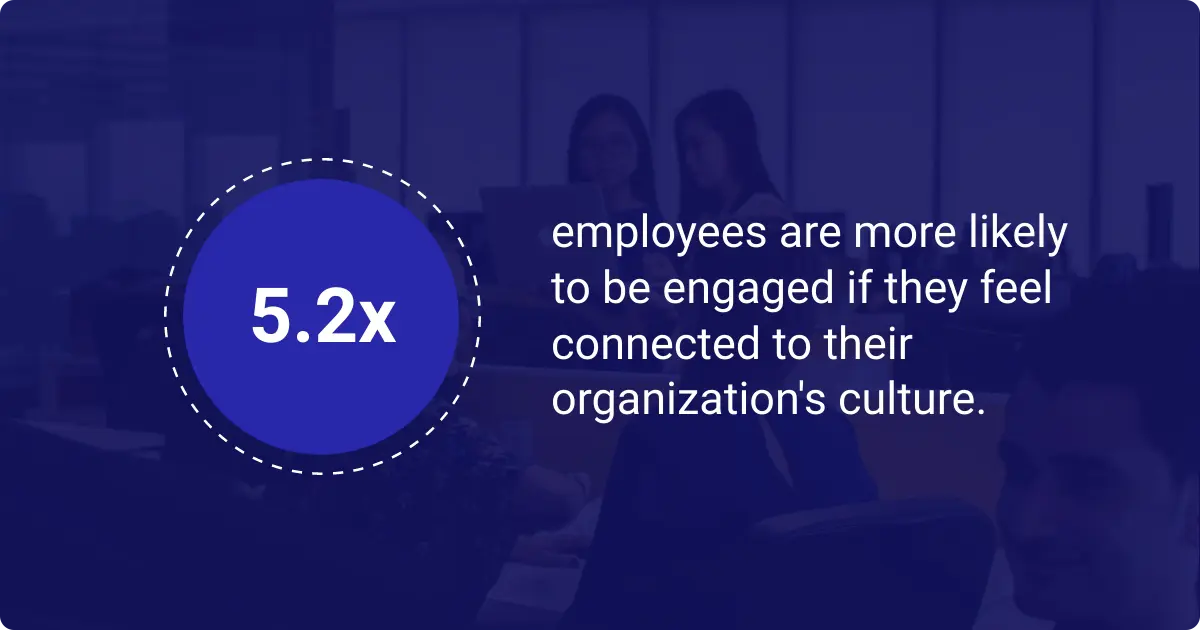
Additionally, in today’s competitive job market, candidates are looking for more than just a paycheck; they want to be part of an organization whose values align with their own. A strong company culture clearly articulated through the mission statement, can differentiate your organization and make it an employer of choice.
In essence, nurturing and maintaining a strong company culture, starting with a clear mission statement, is essential for creating an environment where employees can thrive, and the organization can achieve its long-term goals.
See also: What Is Company Culture If You Don’t Have an Office?
How to build a positive company culture in eight steps
1. Define your core values and beliefs
Core values and beliefs are the foundational principles that guide an organization’s actions, decisions, and interactions. These values reflect what the company stands for and are essential in shaping its identity and culture.
Clearly defining and communicating these values within the organization is crucial for fostering unity and purpose.
How to define your core values and beliefs:
Reflect on the company’s mission and vision
Begin by revisiting your company’s mission statement and vision. These elements should naturally lead to identifying the core values that align with your overarching goals.
Involve key stakeholders
Engage leadership, management, and employees in discussions about what values are most important to the organization. This collaborative approach ensures that the values resonate with everyone in the company.
Identify and prioritize values
List potential values and prioritize them based on their relevance and importance to the company’s mission and vision. Focus on a few key values that truly represent the organization.
Articulate values clearly
Once identified, articulate each value in clear, concise language. Provide explanations and examples of how these values manifest in daily operations and decision-making.
Document and share
Create a formal document outlining the core values and beliefs. Share this document with all employees through onboarding programs, company meetings, and internal communications.
How to communicate core values and beliefs:
Incorporate into onboarding programs
Introduce new hires to the company’s core values during the onboarding process. Ensure they understand the importance of these values and how they are expected to embody them in their roles.
Consistent messaging
Reinforce core values regularly through company-wide communications, such as newsletters, emails, and town hall meetings. Consistency helps embed these values into the company culture.
Lead by example
Leaders and managers should model the core values in their actions and decisions. This sets a standard for the rest of the organization to follow.
Embed in policies and practices
Integrate core values into performance evaluations, reward systems, and hiring processes. This reinforces their importance and encourages aligned behaviors.
Recognition and rewards
Recognize and reward employees who exemplify the core values. Public recognition reinforces the desired behavior and highlights the significance of the values. Then, use your recognition program data to show you which values your employees most frequently use to recognize each other. This will give you insight into what values matter to your team.
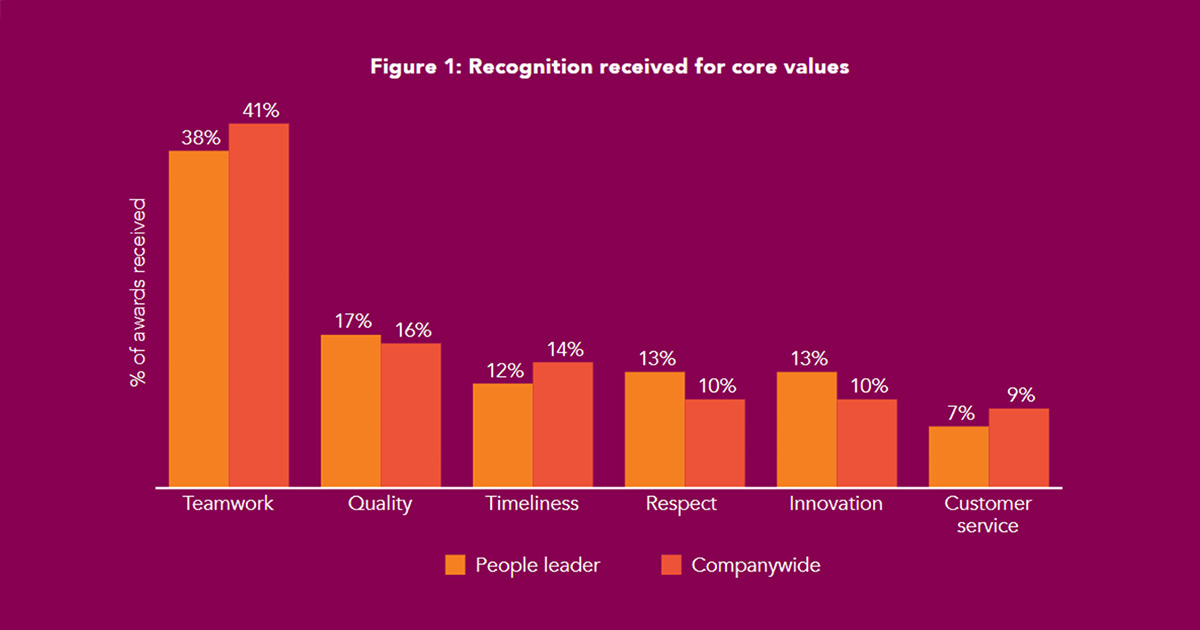
Here are 8+ tips for establishing strong core values and helping your people live them, which strengthens your culture and employer brand.
Download report
Regular review and update
Periodically review the core values to ensure they remain relevant as the organization evolves. Make adjustments as necessary to reflect changes in the company’s mission or strategic direction.
By defining and clearly communicating your core values and beliefs, you create a strong foundation for a cohesive and purpose-driven company culture. These values will guide your organization’s actions and decisions, fostering a unified and motivated workforce.
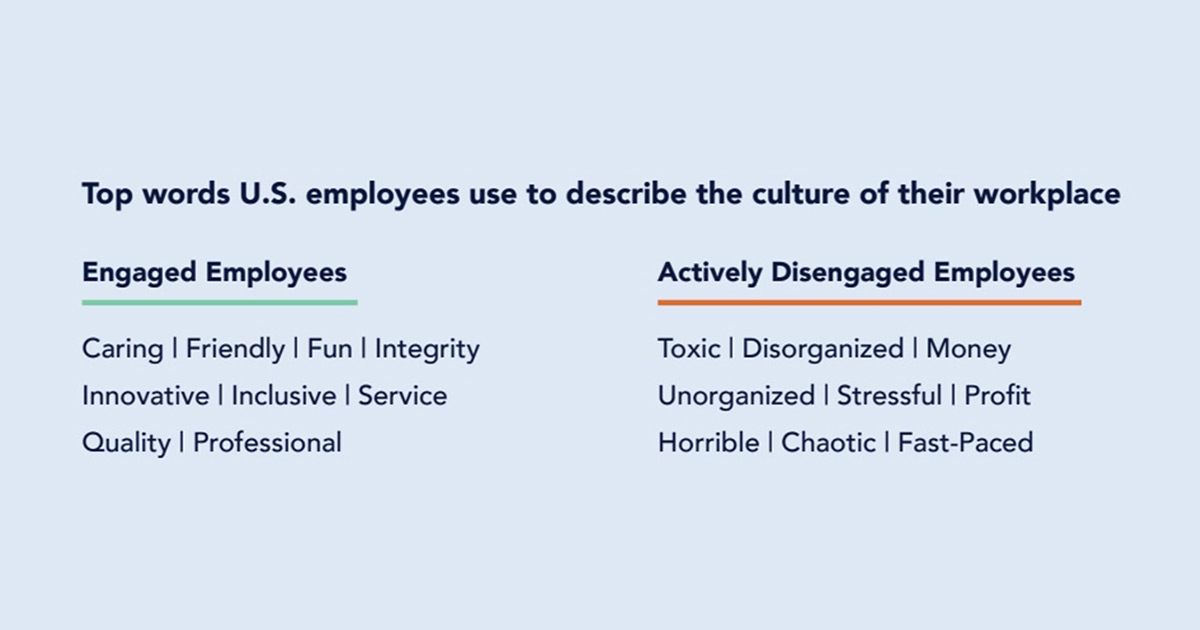
The way engaged employees describe their culture also illustrates how they are uplifted by their day-to-day experiences (“fun,” “caring,” “inclusive”) and the type of work they produce (“innovative,” “quality,” “professional”).
Find out how strategic recognition can save your organization more than $90 million in gained employee productivity. Download the Gallup-Workhuman report to see 3 ways recognition improves business outcomes.
2. Assess your current culture
After defining your core values, the next step is to gauge the current climate of your workplace culture. This assessment is crucial for understanding where your organization stands and identifying gaps between the current state and your desired culture.
Regular evaluations ensure that your culture evolves in alignment with organizational goals and employee needs.
Being by gathering comprehensive data through employee surveys questions about culture, focus groups, and anonymous feedback.
Use surveys to ask specific questions about job satisfaction, communication, and alignment with company values. Follow up with focus groups to delve deeper into specific issues and gather qualitative data. Anonymous feedback mechanisms, such as suggestion boxes or digital platforms, can also encourage candid responses.
By regularly soliciting feedback, organizations can identify patterns and trends that might not be immediately apparent. This continuous loop of feedback helps in understanding employee sentiments and making necessary adjustments in real-time.
Additionally, consider using cultural assessment tools like the Organizational Culture Assessment Instrument (OCAI) to get a structured overview of your current culture. These tools can provide a framework for understanding the different dimensions of your culture and how they align with your desired state.
Assessing your current company culture is not a one-time task but an ongoing process. By regularly assessing your current culture, you can ensure that it evolves in a way that supports your organization’s goals and meets the needs of your employees. This proactive approach fosters a more engaged, productive, and satisfied workforce.
3. Recognize your employees
Recognition plays a crucial role in a positive company culture by both serving as a distinct cultural element and enhancing other aspects of how work gets done. Effective recognition strategies not only acknowledge individual contributions but also reinforce company values and boost overall morale.
Timely and specific recognition is key. Recognizing employees soon after an achievement ensures relevance, while specific praise highlights valued behaviors.
Peer-to-peer recognition fosters a supportive environment, with internal platforms allowing public acknowledgments. Leadership recognition, where leaders regularly celebrate achievements, set a positive example, and demonstrate that hard work is noticed.
Incorporating recognition into daily practices, such as dedicating time in team meetings to share accomplishments, maintains high morale and motivation in the organization.
Linking recognition to company values reinforces those values and encourages desired behaviors. Personalized recognition, tailored to individual preferences, shows genuine appreciation and respect for employees as individuals.
Research from “Empowering Workplace Culture Through Recognition” shows that employees who feel recognized are 3.7x more likely to be engaged and half as likely to experience burnout.
Organizations with effective recognition programs see significant improvements in employee engagement and retention.
By using diverse recognition strategies that are fulfilling, authentic, personalized, equitable, and embedded in the company's culture, companies can create a positive culture that motivates employees and reinforces core values.
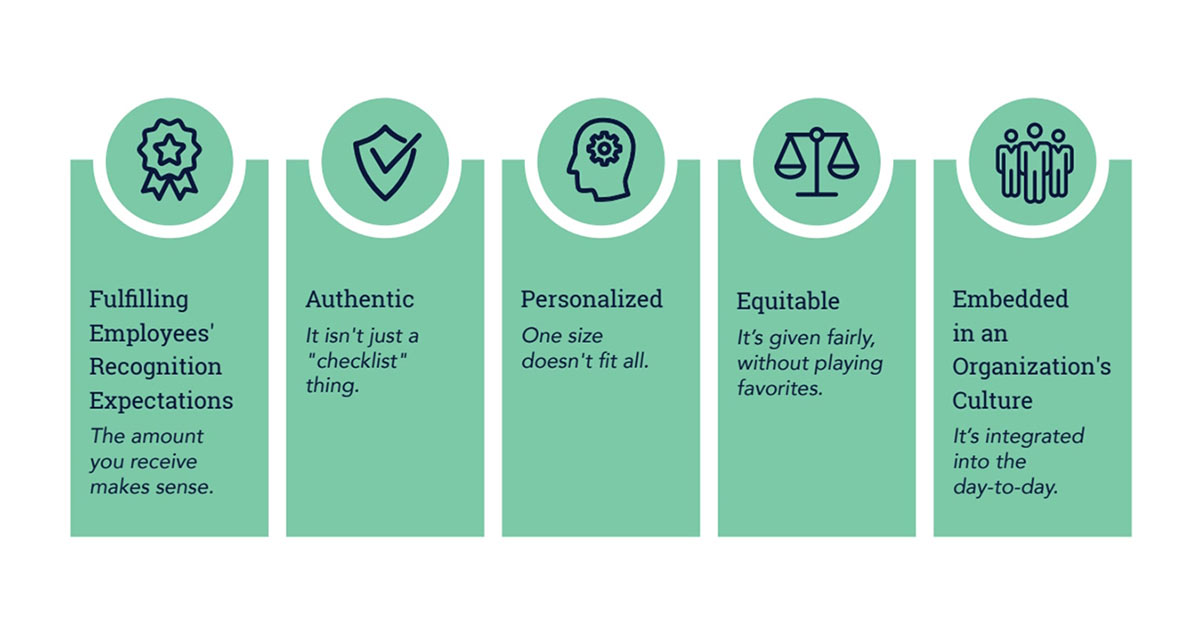
4. Encourage frequent and open communication
To enhance employee engagement and drive team success, it's essential to actively involve team members and encourage transparent communication.
Healthy communication is the backbone of collaborative team efforts. Create a space where your employees can communicate freely without barriers.
Regular team meetings, one-on-one sessions, and open forums for discussion are great ways to maintain clarity, alignment, and trust among team members.
Build psychological safety
When employees feel comfortable providing input and suggestions without fear of judgment or repercussions, it fosters a culture of psychological safety.
This can lead to increased confidence in taking chances and suggesting bold ideas, ultimately contributing to a more innovative and engaged workforce.
In fact, Google’s People Operations team conducted an internal studyOpens in a new tab of more than 250 attributes of more than 180 Google teams. They found the number one driver of successful teams is psychological safety – feeling safe to take risks and be vulnerable at work.
Check-in regularly
The best way to meet employees where they are is to talk to them. This is especially important for managers as the employee-manager relationship is one of the most pivotal at work.
When these relationships are at their best, managers and employees can have consistent conversations about what is challenging, motivating, and stressing employees.
Again, frequency matters. The more frequently employees check in with their managers, the more psychologically safe they feel.
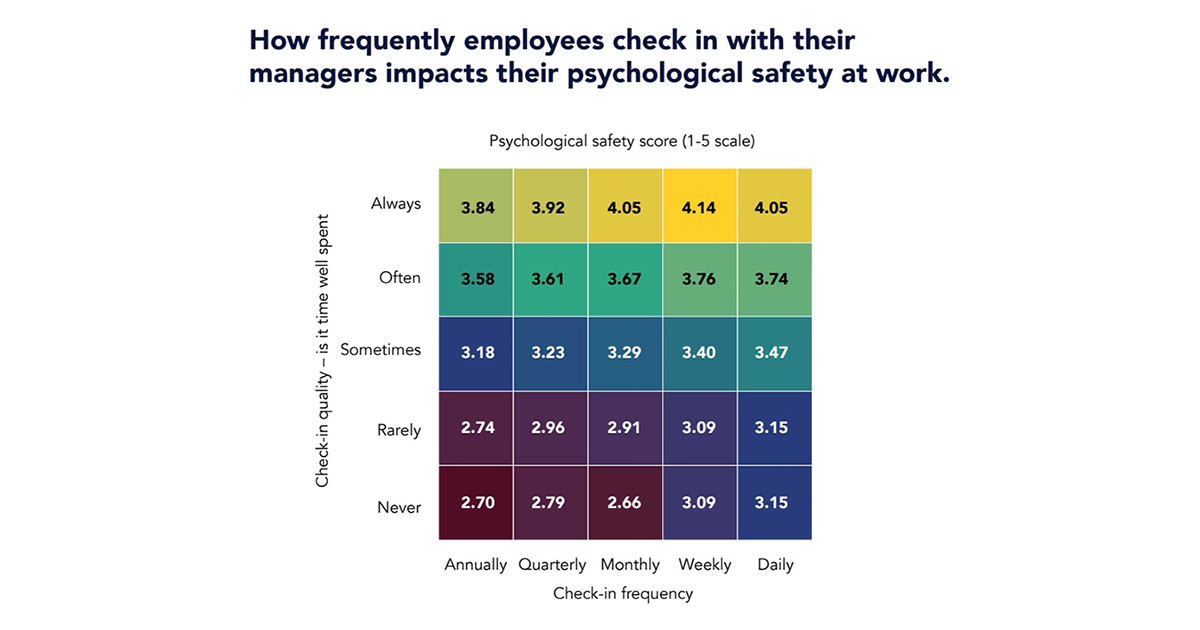
In our survey from “The Evolution of Work: The Value of an Employee-First Culture,” 49% of employees said they check in with their manager at least weekly. Of those respondents checking in at least weekly, 43% report being highly engaged, compared to only 29% for those not checking in at least weekly.
But it could be even better. Nearly 40% of those respondents who check in regularly report that time was only “well spent” sometimes, rarely, or never. It is a missed opportunity, but a correctable problem.
And it makes a big difference. Employees who feel their check-in with their manager was time well spent are less likely to fear losing their jobs.
Open communication strengthens every relationship, including those at work. A regular check-in is one of the best ways to know how employees are doing and how managers and the organization could be supporting them.
5. Develop a positive work environment
A positive work environment is vital to an engaged workforce. According to Gallup’s Tom Rath, “99 out of 100 people report they want to be around positive people, and nine out of 10 report being more productive when they’re around positive people.”
Think of positivity as the fertilizer that helps everything grow. When people feel good, they are more likely to engage and contribute to a supportive community.
To foster a positive work environment, it’s essential to focus on aspects that enhance employee satisfaction and productivity.
Addressing the delicate balance between work and personal life, building relationships, and investing in employee wellness is foundational to cultivating trust and a sense of purpose within your team.
Encourage work-life balance to reduce stress
Promoting work-life balance is crucial for reducing stress and bolstering job satisfaction. You can encourage this by implementing flexible working hours and considering remote work options.
Respect boundaries to ensure your employees have ample time to recharge, leading to higher engagement and retention rates.
Focus on employee wellness
Employee wellbeing is a non-negotiable facet of a thriving work environment. Offer wellness programs or health benefits that cater to both physical and mental health needs. This not only demonstrates care for your team’s health but also contributes to the overall happiness of your employees, which can have a big impact on productivity.
In fact, as noted in our “The Science of Happiness” report, a study by Professor Andrew Oswald, Dr. Eugenio Proto, and Dr. Daniel Sgroi from the Department of Economics at the University of Warwick found that happiness can increase productivity by an average of 12% and reach as high as 20% above the control group.
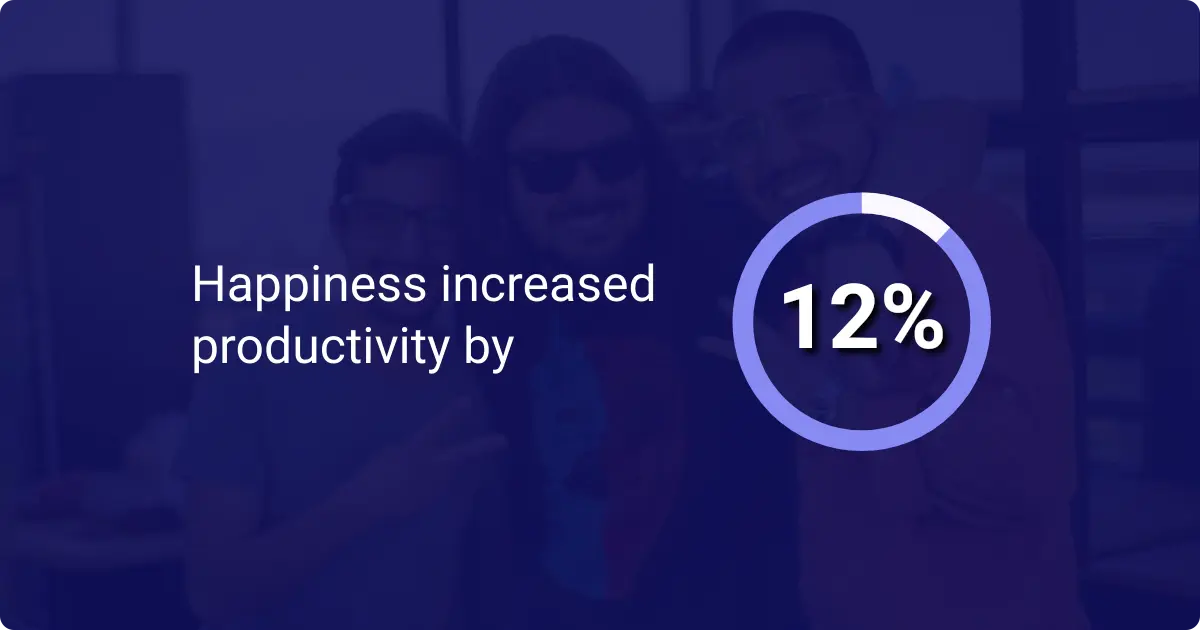
Build workplace relationships
Strong interpersonal relationships can make your workplace feel more welcoming and inclusive.
Gallup's research indicates that employees who have a best friend at work are 43% more likelyOpens in a new tab to have received praise for their work in the last week and are more than twice as likely to be engaged in their jobs.
Encourage collaboration through team-building activities and open communication channels. Maintain a neutral and open attitude to nurture trust and foster a sense of togetherness.
Promote a team atmosphere
A strong team bond and a sense of unity can be achieved by clarifying team objectives and encouraging group projects.
Regular team meetings and collaborative spaces can facilitate a better exchange of ideas and promote a team atmosphere that aligns with the company’s purpose.
Practice flexibility
Adapting to the diverse needs of your employees by practicing flexibility can make a profound impact on job satisfaction.
Flexibility may include offering part-time roles, sabbaticals, or understanding unique personal circumstances. This level of adaptability is a hallmark of a positive work environment and can drive retention and loyalty.
6. Foster a sense of belonging
Belonging is essential when building a strong organizational culture because it significantly influences employee engagement, productivity, and overall wellbeing.
According to Maslow’s Hierarchy of Needs, belonging is a fundamental human need, coming right after physical and safety needs. Many individuals seek their sense of belonging in the workplace, where they spend a substantial part of their lives.
A survey by Ernst & Young found that 34% of people feel their greatest sense of belonging at work, second only to home, often surpassing other community aspects such as neighborhoods or religious institutions.
The science of belonging
Belonging is about creating and maintaining positive, long-term interpersonal relationships. In the workplace, these relationships are formed through social capital and support, which are essential for creating an inclusive environment.
Companies that foster genuine concern and respect among employees build goodwill, leading to increased productivity during stressful times.
Creating a culture of belonging and social support
Belonging is deeply intertwined with social support, a crucial job resource. To foster belonging, companies must create environments conducive to inclusion and support. According to our report, “The Case for Belonging,” essential components include:
Culture of safety and equity
The foundation of belonging is psychological safety. Employees need to trust that they can express their true selves without fear of negative consequences. According to a study by Ernst & Young, 40% of respondents feel isolated at work due to a lack of inclusion.
Establishing a fair and equitable environment where everyone feels valued is crucial. When employees perceive that their contributions are recognized and their identities respected, they are more likely to engage and contribute positively.
Culture of celebration
Recognizing and celebrating life events, both personal and professional, allows employees to bring their whole selves to work.
Our research shows that employees who experience five or more life events celebrated at work are 10% more likely to feel a strong sense of belonging and 14% more likely to perceive their company as having a very human work culture.
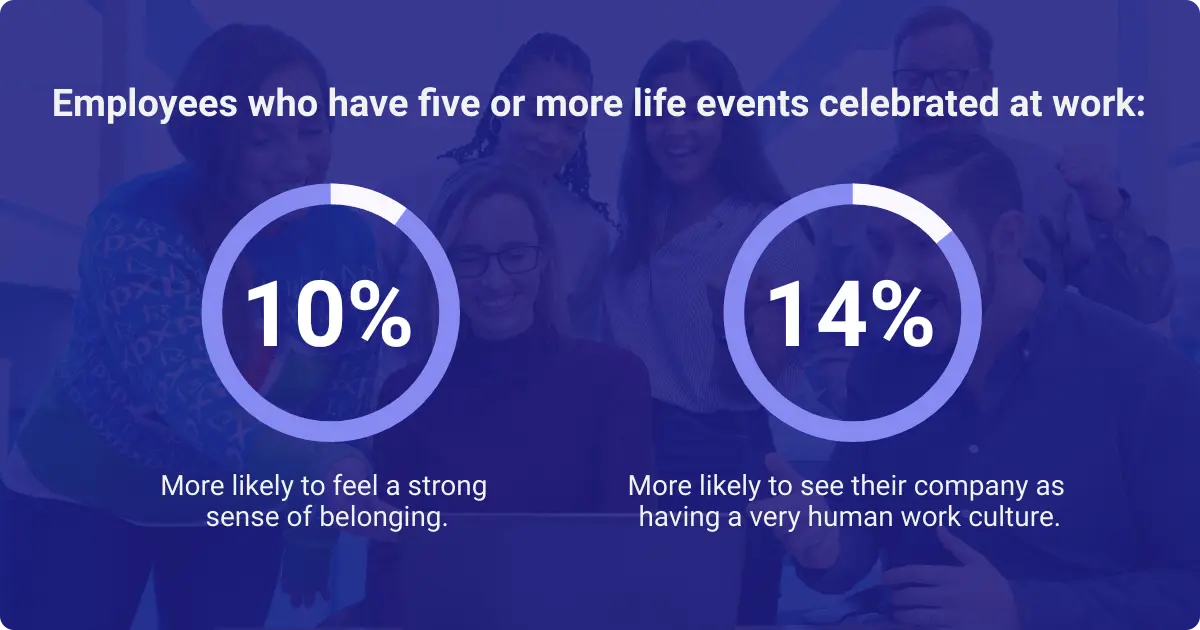
Culture of generosity
One way to avoid that endless set of Wednesdays and amplify belonging is through social exchange: the giving of gifts. This is why we bring a gift to a wedding shower, send one at the birth of a new child, or likewise bring gifts to someone who is experiencing sickness or grief at work.
Encouraging social exchanges through acts of kindness and gift-giving can significantly enhance workplace relationships. Unlike purely economic exchanges, these gestures build trust and a sense of personal obligation.
Culture of inclusion
An inclusive workplace is essential for employee engagement. Ensuring that employees feel included in discussions and decision-making processes can transform the workplace atmosphere.
7. Hiring and onboarding strategies
To foster a thriving company culture, your hiring and onboarding strategies should focus on aligning new hires with your organizational culture from the outset.
This includes identifying candidates who share your core values and adapting your onboarding to support remote workers.
Hire candidates who align with your culture
When recruiting, ensure that job seekers are evaluated not just for their skills but also for their fit with your company's values. This begins by clearly communicating your culture in job descriptions and during interviews.
In “Enriching Organizational Culture Through Values”, we note that when an employee’s personal values align with company values, they are more than 4x as likely to feel connected to their work and the organization as a whole.
Look at some of the ways you can institute core values that reflect the essence of your organization – and how you can make those values “livable.”
Incorporate behavioral questions that allow candidates to demonstrate how their personal values align with those of your organization.
- Ask: "Can you give an example of a time when you demonstrated [company value] at work?"
- Assess: Use scoring rubrics to objectively evaluate cultural fit.
- Include: Involve various team members in the interview process to gauge alignment from multiple perspectives.
Remote hiring and onboarding culture strategies
Remote work demands unique hiring and onboarding practices that still preserve your cultural integrity. Here are focused strategies to align remote hires with your organizational culture:
Virtual interviews
- Conduct video interviews to simulate face-to-face interactions.
- Use virtual reality (VR) tools, if possible, to give candidates a tour of your virtual office.
Digital welcome packages
- Send a welcome message along with detailed digital documents explaining your company culture, expectations, and history.
- Include videos from leadership discussing the importance of culture and core values.
Online training & collaboration
- Provide access to online training modules that include core values education.
- Use collaboration tools to create a sense of team and community among remote employees.
By prioritizing a candidate's alignment with your culture and adapting onboarding strategies to cater to remote hires, you can build a robust and cohesive organizational culture, irrespective of where your team is based.
8. Continuous improvement and adaptation
In a dynamic business landscape, fostering a culture of continuous improvement and adaptation is essential for sustained success.
Leaders must cultivate an environment where employees are encouraged to innovate, develop, and grow with the company, while staying aligned with the fundamental core values of the organization.
Give and solicit regular feedback
Regular feedback is crucial for both personal growth and broader organizational development. As a leader, you should actively solicit and provide candid feedback to continuously elevate performance and drive innovation.
Encourage transparency within your team by making feedback sessions a routine part of your company culture.
Learn from mistakes
Cultivate a culture where mistakes are viewed as opportunities for learning. By examining errors without assigning blame, you foster respect and accountability among team members.
This approach not only leads to valuable insights but also encourages adaptability, a key element for rapid response to change.
Encourage growth through learning and development
Employee learning and development opportunities are crucial to company culture as they foster employee engagement, satisfaction, and productivity.
By providing opportunities for continuous learning and development, organizations demonstrate their commitment to employee growth, which in turn enhances the overall workplace culture, leading to a more motivated and skilled workforce.
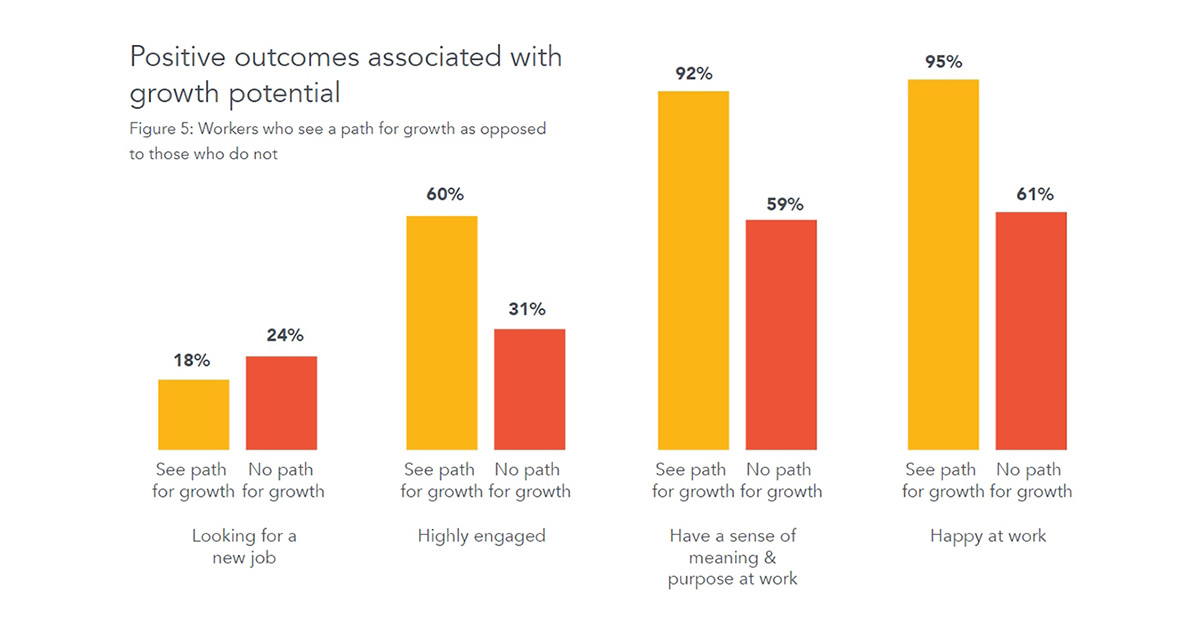
Stay true to your core values
As we noted above, your company’s values are the foundation upon which your organization is built. During times of change, these principles should remain constant, guiding decision-making and actions.
Ensuring that every innovation or shift in strategy aligns with these values reinforces the identity and integrity of your culture.
Monitor and nurture the culture continuously
A healthy and productive organizational culture doesn't maintain itself; it requires continuous nurturing.
Regular check-ins on key cultural metrics like productivity, employee satisfaction, and adaptability can provide valuable insights for maintaining a resilient and forward-thinking environment. Incorporate examples of innovation in the workplace to inspire and further drive continuous improvement.
Conclusion
Building a strong company culture is an ongoing journey that requires continuous effort and commitment. By defining and communicating your core values, regularly assessing the current culture, recognizing employees, and encouraging open communication, you can create a positive and dynamic workplace where employees thrive.
It's essential to link these efforts back to your core values, ensuring that every initiative reinforces the principles that define your organization. Regularly evaluating and adapting your culture helps keep it aligned with your evolving goals and the needs of your employees.
Remember, a strong company culture is not built overnight. It evolves through consistent practices and a genuine commitment to improvement. By fostering a supportive and engaging environment, you can drive long-term success and create a workplace where everyone feels valued and motivated.
Commit to these strategies, and you’ll see the transformative power of positive company culture in achieving your organizational goals.
About the author
Ryan Stoltz
Ryan is a search marketing manager and content strategist at Workhuman where he writes on the next evolution of the workplace. Outside of the workplace, he's a diehard 49ers fan, comedy junkie, and has trouble avoiding sweets on a nightly basis.